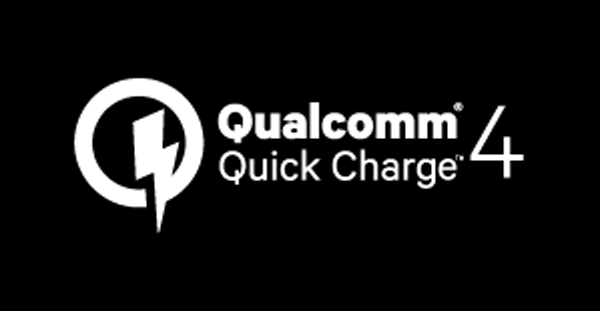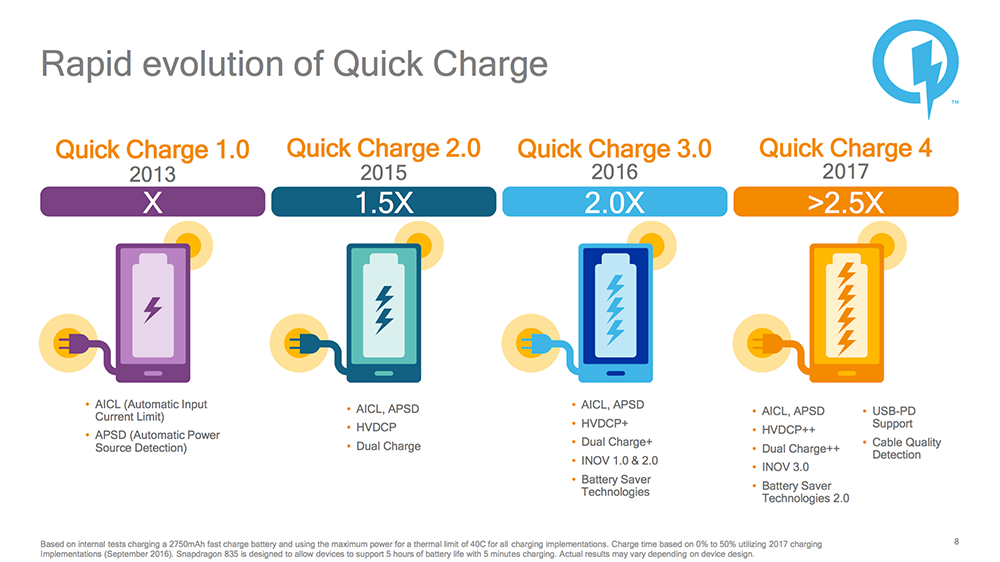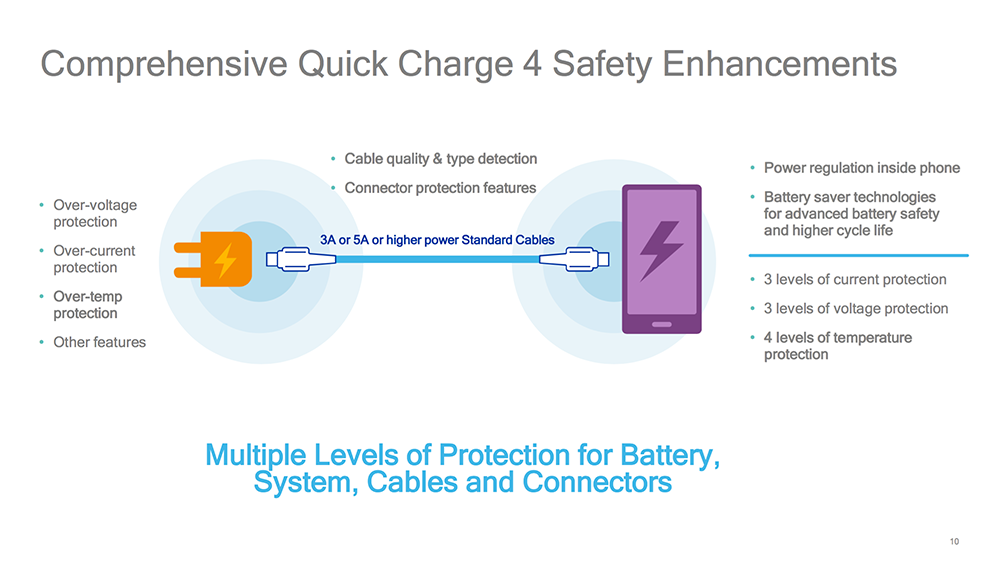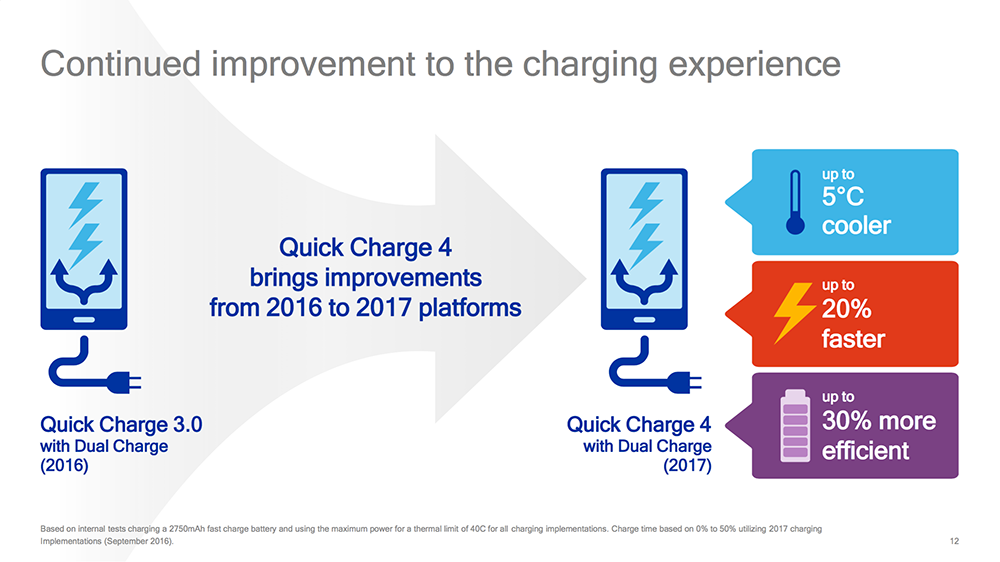Qualcomm Announces Quick Charge 4: Supports USB Type-C Power Delivery
by Matt Humrick on November 17, 2016 7:31 AM EST- Posted in
- Smartphones
- Snapdragon
- Qualcomm
- Mobile

Qualcomm did more than reveal the name of its next SoC, the Snapdragon 835, today at its Snapdragon Technology Summit in New York. It also announced an update to its fast-charging technology. Qualcomm’s Quick Charge 4 promises up to 20% faster charging and 30% higher efficiency than the previous generation Quick Charge 3 found in many current flagship phones.
This latest generation brings a number of improvements, but perhaps the most remarkable change is that Quick Charge 4 is now compatible with the USB Type-C and USB Power Delivery (USB-PD) specifications set by the USB-IF standards body. Previous implementations of Qualcomm’s proprietary charging technology alter the voltage delivered over Vbus to increase the charging rate, which violates the Type-C specification for standard charging that only allows for changing the charging current. They also use a different method for negotiating the charging parameters using the USB data lines that runs afoul of the Type-C specifications too. Quick Charge 4 addresses these issues and should satisfy the language Google recently added to its Android 7 Compatibility Definition Document (CDD) recommending device OEMs not use proprietary charging methods that are not compatible with USB-PD.
Quick Charge 4 also uses an updated version of Qualcomm’s INOV (Intelligent Negotiation for Optimum Voltage) power-management algorithm that now includes real-time thermal management to help optimize power transfer. It also uses an updated version of its Battery Saver Technologies that uses stepwise charging to help the battery maintain at least 80% of its original charge capacity after 500 charge cycles.
Battery health and charging safety are fresh on everyone’s minds after the battery fires that plagued Samsung’s Galaxy Note7. It’s only natural then that Qualcomm made safety a point of emphasis during its presentation. Quick Charge 4 incorporates over-voltage, over-current, and four levels of over-temperature protection, including chassis, battery, and PMIC temperature sensing. It can also sense the type and quality of the charging cable and adds additional protection from over-charging. Qualcomm says that protection “is implemented at multiple levels and throughout the entire charging process to more accurately measure voltage, current, and temperature while protecting the battery, system, cables and connectors.”
Qualcomm’s Quick Charge 4 will be available on devices using the Snapdragon 835 SoC and its two new power managements ICs (PMICs), the SMB1380 and SMB1381. The two PMICs work in tandem as part of the Dual Charge++ feature for improving efficiency, reaching 95% peak efficiency at 3A. The PMICs will be available by the end of 2016 and will be integrated into devices shipping in the first half of 2017.













28 Comments
View All Comments
edzieba - Thursday, November 17, 2016 - link
"This latest generation brings a number of improvements, but perhaps the most remarkable change is that Quick Charge 4 is now compatible with the USB Type-C and USB Power Delivery (USB-PD) specifications set by the USB-IF standards body. "Excellent news, and good for Qualcomm that they are working to reduce the nonsense around charging standards rather than doubling down on their proprietary charging scheme.
A5 - Thursday, November 17, 2016 - link
QC4 is still the voltage-adjustment method. It just isn't mutually exclusive with USB-PD now.witeken - Thursday, November 17, 2016 - link
The only noteworthy news here is the support for USB-PD. There are at least 5 competing fast charging technologies I'm aware of.lmcd - Thursday, November 17, 2016 - link
Wasn't aware that there are 5 actually-used competitors.Seriously, what? The Qualcomm near-monopoly has been well documented.
Impulses - Friday, November 18, 2016 - link
OnePlus has Dash which is radically different and even more proprietary, and some of the other Asian OEM have their own proprietary thing, none quite as widespread as QC obvs.Hopefully aftermarket accessory makers step their game up now, beyond the QC/PD incompatibility, the glut of aftermarket crap that's downright dangerous has been the other major roadblock to wider adoption of PD.
lagittaja - Friday, November 18, 2016 - link
Five? Not sure about that. Unless you're counting rebranded stuff as different and competing. Like VOOC vs. Dash or Quick Charge vs. "Adaptive Fast Charging" vs. BoostMaster and so on.I can count three different competing fast charging methods off the top of my head.
USB-PD
Quick Charge
VOOC / Dash
And off these three two are just shoving a fuckton of angry pixies down the cable and losing a lot of power as heat doing that. And making it even more necessary to use a really high quality cable with thick conductors if you want it to be as efficient and of course as fast as possible.
mmrezaie - Thursday, November 17, 2016 - link
To be sure, now this one works on standard usb-chargers that support usb-pd?SetiroN - Thursday, November 17, 2016 - link
This is the important thing. We need universal chargers, not just certification.A5 - Thursday, November 17, 2016 - link
No, you'll still need proprietary chargers for QC4 support, it just means that you won't fail USB-IF certification by enabling QC.mmrezaie - Saturday, November 19, 2016 - link
Thanks, that's is not good enough then!